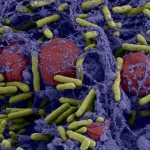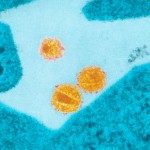Link to Pubmed [PMID] – 15831954
J. Gen. Virol. 2005 May;86(Pt 5):1423-34
Post-translational modifications and correct subcellular localization of viral structural proteins are prerequisites for assembly and budding of enveloped viruses. Coronaviruses, like the severe acute respiratory syndrome-associated virus (SARS-CoV), bud from the endoplasmic reticulum-Golgi intermediate compartment. In this study, the subcellular distribution and maturation of SARS-CoV surface proteins S, M and E were analysed by using C-terminally tagged proteins. As early as 30 min post-entry into the endoplasmic reticulum, high-mannosylated S assembles into trimers prior to acquisition of complex N-glycans in the Golgi. Like S, M acquires high-mannose N-glycans that are subsequently modified into complex N-glycans in the Golgi. The N-glycosylation profile and the absence of O-glycosylation on M protein relate SARS-CoV to the previously described group 1 and 3 coronaviruses. Immunofluorescence analysis shows that S is detected in several compartments along the secretory pathway from the endoplasmic reticulum to the plasma membrane while M predominantly localizes in the Golgi, where it accumulates, and in trafficking vesicles. The E protein is not glycosylated. Pulse-chase labelling and confocal microscopy in the presence of protein translation inhibitor cycloheximide revealed that the E protein has a short half-life of 30 min. E protein is found in bright perinuclear patches colocalizing with endoplasmic reticulum markers. In conclusion, SARS-CoV surface proteins S, M and E show differential subcellular localizations when expressed alone suggesting that additional cellular or viral factors might be required for coordinated trafficking to the virus assembly site in the endoplasmic reticulum-Golgi intermediate compartment.




